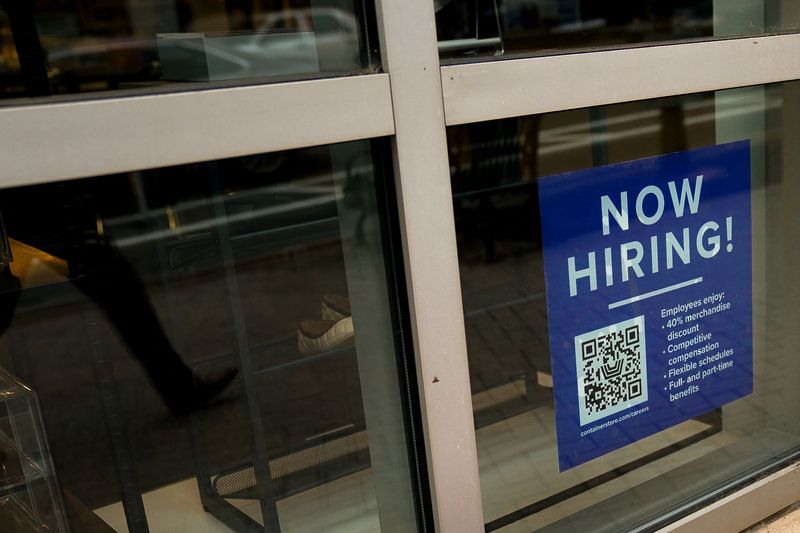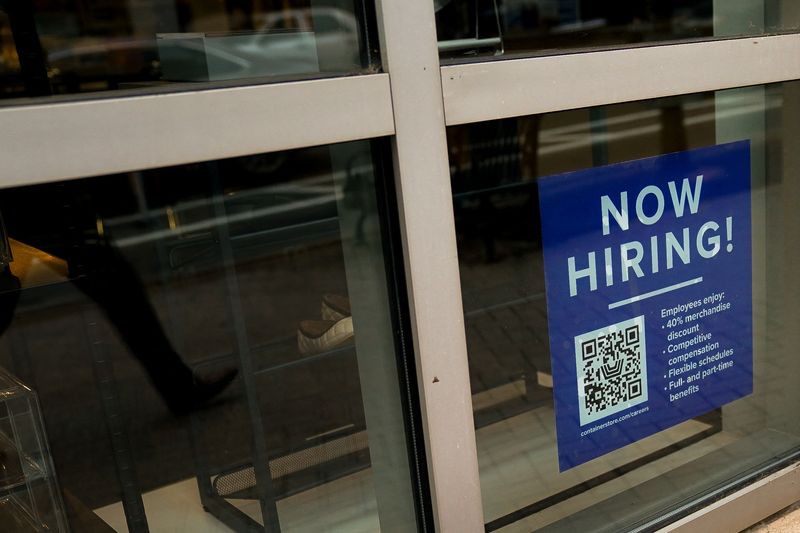Economy
US unemployment rate spikes to 3.8%; labor market still has momentum


© Reuters. FILE PHOTO: An employee hiring sign with a QR code is seen in a window of a business in Arlington, Virginia, U.S., April 7, 2023. REUTERS/Elizabeth Frantz/File Photo
By Lucia Mutikani
WASHINGTON (Reuters) – U.S. job growth picked up in August, but the unemployment rate jumped to 3.8% and wage gains moderated, suggesting that labor market conditions were easing and cementing expectations that the Federal Reserve will not raise interest rates this month.
The closely watched employment report from the Labor Department on Friday also showed 736,000 people entered the job market last month, boosting the participation rate to the highest level in 3-1/2 years. Concerns about an economic slowdown are probably luring people back into the labor market.
The economy created 110,000 fewer jobs than previously reported in June and July, which some economists said suggested there had been business closures that were not previously captured. The report followed news this week that job openings dropped to the lowest level in nearly 2-1/2 years in July.
The labor market is slowing in response to the U.S. central bank’s hefty rate hikes to cool demand in the economy.
“This is probably the final nail in the coffin for the chances of another rate hike by the Fed in September,” said Christopher Rupkey, chief economist at FWDBONDS in New York.
Nonfarm payrolls increased by 187,000 jobs last month after rising by 157,000 in July. Job growth averaged 150,000 per month over the past three months, sharply down from 238,000 in the three months through May.
Economists polled by Reuters had forecast payrolls would increase by 170,000 jobs last month. Employment gains, however, remain well above the roughly 100,000 jobs per month needed to keep up with the increase in the working-age population. The share of industries adding jobs was the highest in seven months, indicating underlying strength in the labor market.
A strike by Hollywood actors resulted in a decrease of 17,000 jobs in the motion picture and sound recording industries last month. The bankruptcy of trucking firm Yellow (OTC:) in early August led to 37,000 job losses in the truck transportation industry. Without these one-time drags, payrolls would have increased by about 241,000 in August.
“This is still not the picture of the labor market we would expect to see if the economy were in danger of decelerating dramatically in the short term, although without question there are signs of moderation,” said Rick Rieder, chief investment officer of global fixed income at BlackRock (NYSE:).
Stocks on Wall Street were trading mostly lower after rising earlier. The dollar gained versus a basket of currencies. U.S. Treasury yields rose.
Though demand for labor is ebbing, some services businesses such as healthcare, restaurants, bars and hotels are still desperate for workers.
Employment gains in August were led by the healthcare sector, which added 71,000 jobs, spread across ambulatory services, hospitals, nursing and residential care facilities.
Leisure and hospitality payrolls increased by 40,000. Employment in the industry remains 290,000 jobs below its pre-pandemic level. The construction industry added 22,000 jobs, while manufacturing payrolls rebounded by 16,000 jobs.
Employment in the professional and business services sector rose by 19,000, but temporary help services, which is seen as a harbinger for future hiring, continued to decline, losing 19,000 positions. Government payrolls increased marginally.
The transportation and warehousing sector shed 34,000 jobs, with employment in the sector also depressed by the loss of 9,000 courier and messenger jobs.
WAGE GROWTH SLOWS
Wage growth moderated last month. Average hourly earnings climbed 0.2%, the smallest rise since February 2022, after gaining 0.4% in July. In the 12 months through August, wages rose 4.3% after increasing 4.4% in July.
Wages are still rising faster than the 3.5% pace that economists say is consistent with the Fed’s 2% target. As fewer people quit their jobs in search of greener pastures, wage growth could continue to trend lower. But some economists are worried that recent union contracts, including one at United Parcel Service (NYSE:), could put upward pressure on wages.
The United Auto Workers last month said members voted overwhelmingly in favor of authorizing a strike at General Motors (NYSE:), Ford Motor (NYSE:) and Stellantis (NYSE:), if an agreement over wages and pension plans was not reached before the current four-year contract expires on Sept. 14.
Since March 2022, the Fed has raised its policy rate by 525 basis points to the current 5.25%-5.50% range. Financial markets are now betting the central bank is done raising rates and may start cutting them next year, according to CME Group’s (NASDAQ:) FedWatch Tool. Futures tied to the Fed’s policy rate show only a slight chance of a rate hike at the Sept. 19-20 meeting.
There was no sign employers were reducing hours last month. The average workweek rose to 34.4 hours from 34.3 in July. That contributed to an increase in aggregate wage income, which should support consumer spending and the overall economy.
The economic outlook also got a boost from other data on Friday showing a surge in construction spending in July and a slower pace of contraction in manufacturing in August.
Though household employment increased by 222,000 in August, it was insufficient enough to absorb the 736,000 people who entered the force.
That pushed the unemployment rate to 3.8%, the highest level since February 2022, from 3.5% in July. The jobless rate remains below the Fed’s latest median estimate of 4.1% by the fourth quarter of this year. The rise in the jobless rate was concentrated among young adults.
The labor force participation rate, or the proportion of working-age Americans who have a job or are looking for one, increased to 62.8%. That was the highest level since February 2020 and was up from 62.6% in July. The rise was mostly among young adults and women aged 55 and older.
“The increase among women 55 years and older is promising if it continues, as it could signal the end of the early retirement trend,” said Stephen Juneau, a U.S economist at Bank of America Securities in New York. “The increase among men 16-19 is mixed news because these workers probably are not in college and are now less likely to go.”
Economy
Russian central bank says it needs months to make sure CPI falling before rate cuts -RBC


© Reuters. Russian Central Bank Governor Elvira Nabiullina attends a news conference in Moscow, Russia June 14, 2019. REUTERS/Shamil Zhumatov/File Photo
MOSCOW (Reuters) – Russia’s central bank will need two to three months to make sure that inflation is steadily declining before taking any decision on interest rate cuts, the bank’s governor Elvira Nabiullina told RBC media on Sunday.
The central bank raised its key interest rate by 100 basis points to 16% earlier in December, hiking for the fifth consecutive meeting in response to stubborn inflation, and suggested that its tightening cycle was nearly over.
Nabiullina said it was not yet clear when exactly the regulator would start cutting rates, however.
“We really need to make sure that inflation is steadily decreasing, that these are not one-off factors that can affect the rate of price growth in a particular month,” she said.
Nabiullina said the bank was taking into account a wide range of indicators but primarily those that “characterize the stability of inflation”.
“This will take two or three months or more – it depends on how much the wide range of indicators that characterize sustainable inflation declines,” she said.
The bank will next convene to set its benchmark rate on Feb. 16.
The governor also said the bank should have started monetary policy tightening earlier than in July, when it embarked on the rate-hiking cycle.
Economy
China identifies second set of projects in $140 billion spending plan


© Reuters. FILE PHOTO: Workers walk past an under-construction area with completed office towers in the background, in Shenzhen’s Qianhai new district, Guangdong province, China August 25, 2023. REUTERS/David Kirton/File Photo
SHANGHAI (Reuters) – China’s top planning body said on Saturday it had identified a second batch of public investment projects, including flood control and disaster relief programmes, under a bond issuance and investment plan announced in October to boost the economy.
With the latest tranche, China has now earmarked more than 800 billion yuan of its 1 trillion yuan ($140 billion) in additional government bond issuance in the fourth quarter, as it focuses on fiscal steps to shore up the flagging economy.
The National Development and Reform Commission (NDRC) said in a statement on Saturday it had identified 9,600 projects with planned investment of more than 560 billion yuan.
China’s economy, the world’s second largest, is struggling to regain its footing post-COVID-19 as policymakers grapple with tepid consumer demand, weak exports, falling foreign investment and a deepening real estate crisis.
The 1 trillion yuan in additional bond issuance will widen China’s 2023 budget deficit ratio to around 3.8 percent from 3 percent, the state-run Xinhua news agency has said.
“Construction of the projects will improve China’s flood control system, emergency response mechanism and disaster relief capabilities, and better protect people’s lives and property, so it is very significant,” the NDRC said.
The agency said it will coordinate with other government bodies to make sure that funds are allocated speedily for investment and that high standards of quality are maintained in project construction.
($1 = 7.1315 renminbi)
Economy
Russian central bank says it needs months to make sure CPI falling before rate cuts -RBC


© Reuters. Russian Central Bank Governor Elvira Nabiullina attends a news conference in Moscow, Russia June 14, 2019. REUTERS/Shamil Zhumatov/File Photo
MOSCOW (Reuters) – Russia’s central bank will need two to three months to make sure that inflation is steadily declining before taking any decision on interest rate cuts, the bank’s governor Elvira Nabiullina told RBC media on Sunday.
The central bank raised its key interest rate by 100 basis points to 16% earlier in December, hiking for the fifth consecutive meeting in response to stubborn inflation, and suggested that its tightening cycle was nearly over.
Nabiullina said it was not yet clear when exactly the regulator would start cutting rates, however.
“We really need to make sure that inflation is steadily decreasing, that these are not one-off factors that can affect the rate of price growth in a particular month,” she said.
Nabiullina said the bank was taking into account a wide range of indicators but primarily those that “characterize the stability of inflation”.
“This will take two or three months or more – it depends on how much the wide range of indicators that characterize sustainable inflation declines,” she said.
The bank will next convene to set its benchmark rate on Feb. 16.
The governor also said the bank should have started monetary policy tightening earlier than in July, when it embarked on the rate-hiking cycle.

 Forex2 years ago
Forex2 years agoForex Today: the dollar is gaining strength amid gloomy sentiment at the start of the Fed’s week

 Forex2 years ago
Forex2 years agoHow is the Australian dollar doing today?

 Forex1 year ago
Forex1 year agoUnbiased review of Pocket Option broker

 Forex2 years ago
Forex2 years agoDollar to pound sterling exchange rate today: Pound plummeted to its lowest since 1985

 Cryptocurrency2 years ago
Cryptocurrency2 years agoWhat happened in the crypto market – current events today

 World2 years ago
World2 years agoWhy are modern video games an art form?

 Stock Markets2 years ago
Stock Markets2 years agoMorgan Stanley: bear market rally to continue

 Economy2 years ago
Economy2 years agoCrude oil tankers double in price due to EU anti-Russian sanctions

































